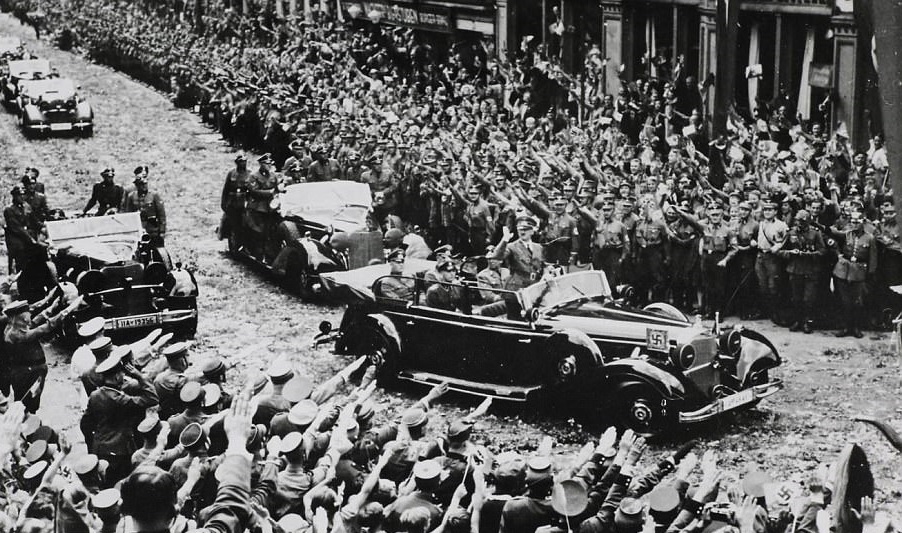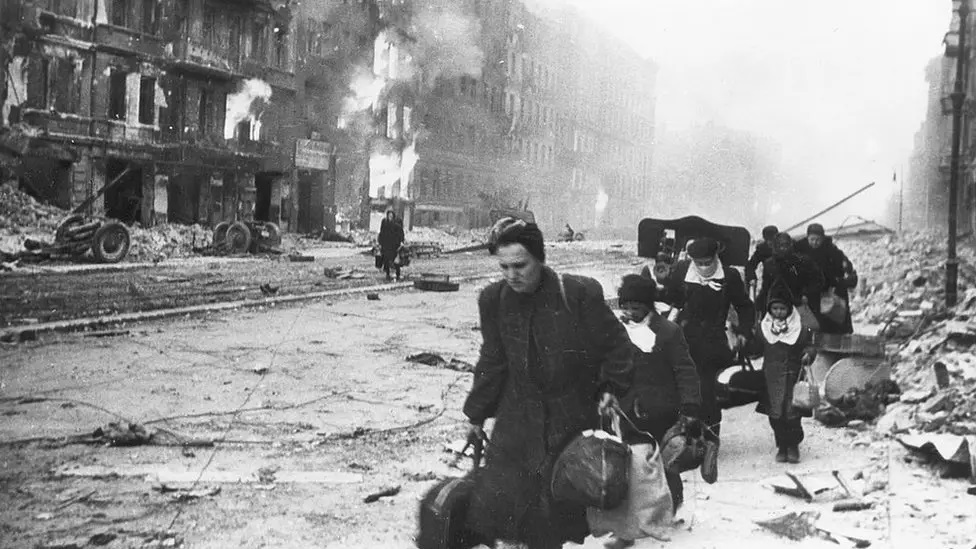|
|
NOTE: the War is a key topic on the OCR specification. The AQA and iGCSE specifications ask only about the the impact of the War on Germany, but it will help to know the background. The Edexcel specification ends at 1939; the War is NOT an Edexcel topic.
|
|
The Nazis only occasionally used the name Der Zweite Weltkrieg (Second World War) in official documents and communications. In public propaganda they called it Der Verteidigungskrieg (The Defensive War), Der Befreiungskrieg (The War of Liberation) and Der Krieg gegen den Bolschewismus (The War Against Bolshevism). The following tells the story of the war from Germany’s PoV:
|
Going DeeperThe following links will help you widen your knowledge: Basic accounts from BBC Bitesize
YouTube
|
Early Triumphs (1939–1941)
Crowds cheer Hitler on his victory parade following the fall of France, 6 July 1940.
Invasion of Poland (September 1939): Hitler was surprised when Britain declared war – his foreign minister Ribbentrop had assured him that Britain and France would back down. But the military success of Blitzkrieg bolstered confidence. Fall of France (June 1940): A major triumph and vindication of Nazi ideology, and the humiliating defeat of the French. Hitler held a victory parade in Paris and publicly overturned the Treaty of Versailles. Battle of Britain (July–October 1940): A disappointment; plans for an invasion were thwarted, and the Blitz failed to force Britain into surrender. Britain, however, was on its knees, and the Nazis were clearly still winning the war. Invasion of Denmark and Norway (April 1940): Secured strategic resources (iron ore) and access to the North Atlantic. Tripartite Pact (September 1940): Formalized the Axis alliance with Italy and Japan, making Nazi Germany part of a global super-bloc. Invasion of the Balkans and Greece (April 1941): To support the Italian invasion of Greece, which was failing. The Nazi invasion was a sweeping success, but Hitler was now fighting a war on two fronts. Capture of Tobruk (June 1942): To support the Italian war in North Africa, which was failing. The Nazis secured a major victory, but at the cost of further extending their war.
|
|
Turning Points (1941–1943)
Invasion of Russia: At its time, the largest military operation in history and the enactment of Hitler’s Lebensraum vision. But ‘the Eastern Front’ turned out to be a disastrous failure and a thing of horror that destroyed civilian confidence.
Pearl Harbor (December 1941): Hitler was not told about the attack, which forced him (as art of the Tripartite Agreement) to declare war on America. At the time, he hoped the war in the Pacific would prevent America intervening in Europe. He was wrong; Pearl Habor brought the full might of the US into the war, expanding the war into a global conflict Germany was too small to win. Wannsee Conference (January 1942): Decision to implement the ‘Final Solution’, leading to the Holocaust. Significant military resources were diverted to exterminate the Jews; the Nazis argued that they were a ‘fifth column’, ‘useless eaters’ consuming resources without helping the war effort, and that a world free of Jews was what they were fighting for. Fall of Tunisia (May 1943): Defeat at El Alamein (November 1942), was followed in May 1943 by the surrender of 250,000 Axis soldiers, and the loss not only of North Africa, but of control of the Mediterranean.
|
|
Collapse and Defeat (1943–1945)
Defeat at Kursk (July–August 1943): The largest tank battle in history; ended the Nazis attempt to regain the initiative in the East. Allied Bombing Campaign (1943 onwards): devastated German cities, killed 3.5 million German civilians, destroyed civilian morale, and removed Germany’s industrial capacity. Italian Armistice (September 1943): Collapse of Mussolini’s; the Allies gained control of Italy and invaded from southern Europe. D-Day Invasion (June 1944): Opening of the long-feared Western Front. Volkssturm (September 1944): a kind of Home Guard, of males too old or young to be called up, was formed under Goebels. By the end of the war, children of 14 and 15, and as young as 9, were fighting (and were hanged if they refused). Failure of the Ardennes Offensive: Last major Nazi counteroffensive ended at the Battle of the Bulge, December 1944. Hitler’s Suicide and Fall of Berlin (April–May 1945): total collapse of the Nazi regime. Surrender (8 May 1945): the interim 'Flensburg' government of Germany surrendered unconditionally, giving up all functions of government, handing over all power to the Allies, and agreeing to "the complete disarmament, demilitarization and dismemberment of Germany".
|
Why did the Nazis fight to the bitter end?1. They knew they faced trial and execution for war crimes. 2. For many, esp. in the SS, WWII was an ideological war, a conflict of light against darkness. 3. The Allies were demanding an unconditional surrender. 4. They believed that the Soviet forces would slaughter/ rape them. 5. Hitler hoped that the differences between the USSR and the USA/Britain would break out into war, and allow Germany to survive.
|
|
Germans fleeing Berlin as the Soviet forces advance in 1945.
|
Consider:1. ‘The Defensive War’, ‘The War of Liberation’ (of the German people), ‘The War Against Bolshevism’: what do these names tell us about the Nazis attitude to the War? 2. Studying the events of the war, what would you identify as. 3. What evidence can you see in the events that, for the Nazis, the war was as much about ideology as about power and territory.
|
|
|
|
|
Spotted an error on this page? Broken link? Anything missing? Let me know. |
|

